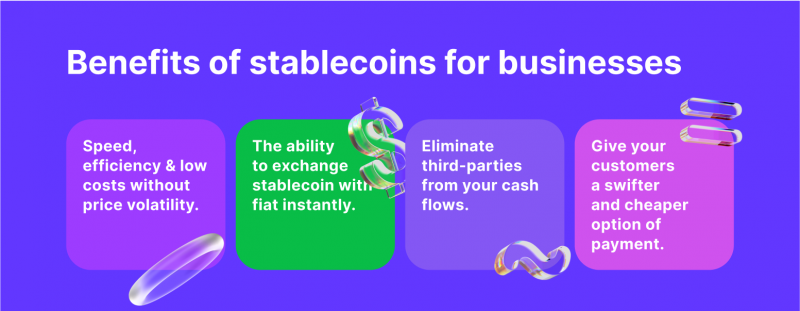Stablecoins: Safe Havens in the Crypto Market
1.What is a Stablecoin?
A stablecoin is a type of cryptocurrency designed to maintain a stable value by pegging its price to another asset or a basket of assets, such as a fiat currency like the US Dollar or commodities like gold. Unlike traditional cryptocurrencies such as Bitcoin, which can experience significant price volatility, stablecoins aim to provide a reliable and consistent store of value. The stability is achieved through various mechanisms, including holding reserves in the pegged asset, algorithmic adjustments, or a combination of both. Stablecoins play a crucial role in the crypto market, serving as a bridge between the decentralized and traditional financial systems. They offer a less volatile alternative for users who seek the benefits of blockchain technology without exposing themselves to the price fluctuations commonly associated with other cryptocurrencies.
2.Types and Features of Stablecoins
Stablecoins come in various types, each with distinct features catering to different needs within the cryptocurrency ecosystem. One prevalent category is fiat-collateralized stablecoins, which are pegged to traditional currencies like the US Dollar or Euro. These stablecoins maintain stability by holding equivalent reserves of the fiat currency in a bank account. Another type is crypto-collateralized stablecoins, which are backed by other cryptocurrencies. These often utilize smart contracts and decentralized finance (DeFi) protocols to manage the collateral and ensure stability.
Algorithmic stablecoins form a unique category that relies on algorithms and smart contracts to control the token's supply and demand dynamically. This mechanism adjusts the coin's value without the need for direct collateral backing. Hybrid stablecoins combine elements of multiple types, offering a balance between decentralization, stability, and scalability.
Features of stablecoins include their ability to facilitate seamless transactions, act as a store of value, and provide a reliable unit of account. Their relatively stable nature makes them suitable for various use cases, such as remittances, trading, and as a stable medium of exchange within decentralized applications. As the crypto space continues to evolve, the development of new stablecoin types and features remains an active area of exploration and innovation.
3.Methods of Backing the Value of Stablecoins
Stablecoins employ various methods to secure and back their value, ensuring a stable peg to the chosen asset. One common approach involves fiat-collateralization, where stablecoins are backed by reserves of traditional currencies, such as the US Dollar or Euro, held in a bank. The transparency and stability of these fiat reserves help maintain the stablecoin's value.
Crypto-collateralization is another method, wherein stablecoins are backed by other cryptocurrencies. Smart contracts and decentralized protocols manage these collateral assets, ensuring a balance between stability and decentralization. The value is often maintained through over-collateralization, requiring users to deposit more crypto assets than the value of the stablecoins issued.
Algorithmic stablecoins use algorithmic mechanisms and smart contracts to regulate the token's supply and demand dynamically. These algorithms adjust the circulating supply based on market conditions, influencing the stablecoin's value without direct collateral backing. This method aims to provide stability while minimizing the need for constant auditing and traditional reserves.
Hybrid models combine elements of both fiat and crypto collateralization or algorithmic mechanisms. These models strive to capture the benefits of different approaches, offering a balance between stability, decentralization, and scalability.
The choice of backing method often depends on the stability and transparency goals of the stablecoin project, as well as the desired level of decentralization within the cryptocurrency ecosystem.
4.The Role of Stablecoins in the Crypto Market
Stablecoins play a pivotal role in the cryptocurrency market, acting as a crucial bridge between the volatile world of digital assets and the more stable traditional financial systems. One primary function of stablecoins is to provide a reliable and consistent store of value in a space where price fluctuations are inherent. Traders and investors often use stablecoins as a safe haven during times of market turbulence, allowing them to swiftly move funds in and out of the crypto market without exposure to the volatility associated with other cryptocurrencies like Bitcoin or Ethereum.
Moreover, stablecoins facilitate seamless transactions within the cryptocurrency ecosystem. Their stable value makes them an ideal medium of exchange for various crypto-based activities, including trading, remittances, and decentralized applications. Stablecoins also serve as a benchmark for pricing other assets in the crypto market, contributing to overall market stability and providing a reference point for assessing the value of different digital assets.
In the realm of decentralized finance (DeFi), stablecoins are fundamental, serving as the preferred currency for lending, borrowing, and yield farming. Users leverage stablecoins to engage in DeFi protocols, taking advantage of the benefits of blockchain technology without exposing themselves to the price volatility associated with more speculative cryptocurrencies.
Overall, stablecoins enhance liquidity, mitigate risk, and promote wider adoption of blockchain technology by offering a stable and reliable alternative within the dynamic cryptocurrency landscape. Their multifaceted role makes them a cornerstone for the sustainable growth and development of the entire crypto market.
5.Advantages and Challenges of Stablecoins
Stablecoins present several advantages within the cryptocurrency ecosystem, but they are not without their challenges. One notable advantage is their ability to offer a relatively stable store of value. This stability makes them an attractive option for users seeking to mitigate the inherent volatility of traditional cryptocurrencies like Bitcoin. Stablecoins serve as a reliable medium of exchange, facilitating seamless transactions within the crypto market without the uncertainty associated with price fluctuations.
Additionally, stablecoins play a crucial role in decentralized finance (DeFi) applications. They provide a stable unit of account for lending, borrowing, and yield farming, enabling users to participate in financial activities on blockchain platforms while avoiding the risks associated with volatile assets.
However, stablecoins face challenges, and one significant concern is maintaining the peg to their underlying assets. External factors such as regulatory changes, market demand, or technological issues can pose risks to the stability of stablecoins. Ensuring transparency and proper collateralization mechanisms are crucial to addressing these challenges.
Another challenge is regulatory scrutiny, as stablecoins often operate in a regulatory gray area. Striking a balance between regulatory compliance and the decentralized nature of cryptocurrencies poses an ongoing challenge for stablecoin projects.
Despite these challenges, the advantages of stablecoins in terms of stability, usability, and their integral role in DeFi make them a valuable component of the evolving crypto landscape. As the industry matures, addressing these challenges will be essential for stablecoins to continue playing a prominent role in the broader financial ecosystem.
6.Regulation of Stablecoins
The regulation of stablecoins has become a focal point for financial authorities as these digital assets gain prominence within the cryptocurrency space. Given their potential impact on traditional financial systems, regulators are keen to establish frameworks that ensure stability, consumer protection, and compliance with existing financial laws.
One key regulatory concern revolves around the nature of stablecoin backing. Regulators often seek assurances that stablecoins are adequately collateralized, especially those pegged to fiat currencies. Transparency in maintaining reserves and adherence to regulatory standards are crucial to mitigate risks related to solvency and protect the interests of stablecoin users.
Moreover, regulatory authorities are exploring how stablecoins fit into existing financial regulatory frameworks. Issues such as anti-money laundering (AML) and combating the financing of terrorism (CFT) compliance, investor protection, and systemic risk are significant considerations. Striking a balance between fostering innovation and safeguarding financial stability is a challenge regulators face as they navigate the evolving landscape of stablecoin adoption.
The international nature of stablecoin transactions also adds complexity to the regulatory discussion. Coordination among global regulators is essential to address cross-border implications and ensure a harmonized approach to stablecoin oversight.
As the crypto industry matures, regulatory developments are anticipated to play a crucial role in shaping the future of stablecoins. Striking the right balance between fostering innovation, protecting users, and maintaining financial stability will be pivotal in establishing a conducive regulatory environment for the responsible growth of stablecoins in the broader financial ecosystem.
7.The Future and Innovation of Stablecoins
The future of stablecoins holds significant promise as ongoing innovation continues to reshape the landscape of digital assets and decentralized finance (DeFi). One avenue of innovation lies in the development of more efficient and sophisticated algorithms for algorithmic stablecoins. These algorithms aim to enhance price stability by dynamically adjusting the coin's supply based on market conditions, offering a decentralized alternative to traditional stablecoins.
Interoperability is another area of focus for the future of stablecoins. Efforts are being made to create protocols that facilitate seamless cross-chain transactions, allowing stablecoins to move effortlessly between different blockchain networks. This would contribute to increased liquidity and accessibility for stablecoins across diverse platforms.
Furthermore, the integration of stablecoins with emerging technologies, such as blockchain oracles and smart contracts, is poised to bring about new use cases and functionalities. This could lead to the development of programmable stablecoins that automate complex financial transactions within DeFi ecosystems. In terms of regulatory developments, the future will likely see increased collaboration between industry stakeholders and regulators to establish clear guidelines and frameworks for stablecoin issuance and operation. Regulatory clarity is crucial for fostering mainstream adoption and institutional participation in the stablecoin space.
In terms of regulatory developments, the future will likely see increased collaboration between industry stakeholders and regulators to establish clear guidelines and frameworks for stablecoin issuance and operation. Regulatory clarity is crucial for fostering mainstream adoption and institutional participation in the stablecoin space.
As stablecoins evolve, their role in traditional finance may expand, potentially serving as a bridge between traditional banking systems and the decentralized world of cryptocurrencies. Overall, the future and innovation of stablecoins hold the promise of a more stable, efficient, and interconnected financial ecosystem, providing users with a reliable medium of exchange and a foundation for continued advancements in decentralized finance.
My Other Articles
Central Bank Digital Currencies
Web3 in Action: DApps, Protocols, and the Evolution of the Internet
Metamask: Navigating the World of Cryptocurrency with Ease
The Greatest Threat in World History: World War III and Warnings for the Future
Coins vs. Fiat: The Battle for Dominance in the Financial Landscape


































